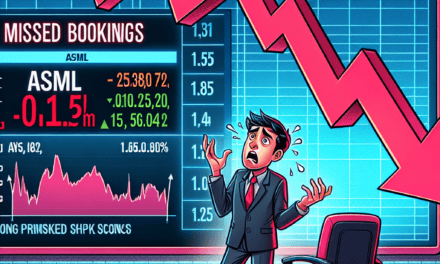“Super Micro’s Stock Slump: Navigating the Downward Spiral Toward Yearly Lows”
Introduction
Super Micro Computer, Inc. (SMCI), a prominent player in the high-performance computing and server solutions market, has recently experienced a notable decline in its stock value, edging closer to its yearly losses. This downturn comes amid a broader market volatility and specific challenges faced by the company, including supply chain disruptions and increased competition in the tech industry. Investors are closely monitoring the situation as Super Micro’s stock performance raises concerns about its financial health and future growth prospects. The company’s ability to navigate these challenges will be crucial in determining its trajectory in the coming months.
Analysis Of Super Micro’s Recent Stock Performance
Super Micro Computer, Inc., a prominent player in the high-performance computing solutions market, has recently experienced a notable decline in its stock value, raising concerns among investors and analysts alike. This downturn is particularly significant as it approaches the threshold of yearly losses, a situation that warrants a closer examination of the factors contributing to this trend. To understand the current trajectory of Super Micro’s stock, it is essential to consider both the internal dynamics of the company and the broader market conditions that have influenced its performance.
Firstly, it is important to acknowledge the competitive landscape in which Super Micro operates. The technology sector is characterized by rapid innovation and intense competition, with numerous companies vying for market share. Super Micro, known for its server and storage solutions, faces stiff competition from industry giants such as Dell Technologies, Hewlett Packard Enterprise, and Lenovo. This competitive pressure necessitates continuous investment in research and development to maintain a technological edge, which can strain financial resources and impact profitability.
Moreover, the global supply chain disruptions that have plagued the technology sector cannot be overlooked. The COVID-19 pandemic has led to significant challenges in the procurement of essential components, such as semiconductors, which are critical to Super Micro’s product offerings. These disruptions have resulted in production delays and increased costs, further affecting the company’s bottom line. Consequently, investors have become increasingly cautious, as uncertainties surrounding supply chain stability continue to loom large.
In addition to these external factors, Super Micro’s internal financial health has also played a role in its stock performance. Recent financial reports have indicated a mixed picture, with some quarters showing growth in revenue while others have highlighted declining profit margins. This inconsistency has led to fluctuating investor confidence, as stakeholders seek more predictable and sustainable financial outcomes. Furthermore, any strategic missteps or delays in product launches can exacerbate these concerns, leading to further volatility in stock prices.
Transitioning to the macroeconomic environment, it is evident that broader market trends have also influenced Super Micro’s stock trajectory. The technology sector, while generally resilient, is not immune to economic downturns and shifts in investor sentiment. Rising interest rates and inflationary pressures have prompted a reevaluation of growth stocks, with investors gravitating towards more stable and value-oriented investments. This shift in investment strategy has contributed to the decline in Super Micro’s stock, as it is perceived as a growth-oriented company with inherent risks.
Despite these challenges, it is crucial to recognize the potential for recovery and growth within Super Micro. The company has demonstrated resilience in the past, leveraging its expertise in high-performance computing to capture emerging opportunities in areas such as artificial intelligence, cloud computing, and edge computing. By capitalizing on these trends and addressing supply chain vulnerabilities, Super Micro can position itself for a rebound in stock performance.
In conclusion, the recent decline in Super Micro’s stock value is a multifaceted issue, influenced by competitive pressures, supply chain disruptions, internal financial dynamics, and broader market conditions. While the approach towards yearly losses is concerning, it is not without potential avenues for recovery. Investors and analysts will undoubtedly continue to monitor the company’s strategic initiatives and market developments closely, as they seek to navigate the complexities of the technology sector and make informed decisions regarding Super Micro’s future prospects.
Factors Contributing To Super Micro’s Stock Decline
Super Micro’s stock has been on a downward trajectory, with recent declines pushing it closer to significant yearly losses. Several factors have contributed to this unsettling trend, each playing a crucial role in shaping investor sentiment and market performance. Understanding these elements is essential for stakeholders and potential investors who are closely monitoring the company’s financial health and strategic direction.
To begin with, the broader economic environment has exerted considerable pressure on Super Micro’s stock performance. Global economic uncertainties, including fluctuating interest rates and inflationary pressures, have created a challenging landscape for many technology companies. As a result, investors have become increasingly cautious, often opting to divest from stocks perceived as high-risk. This macroeconomic backdrop has undoubtedly influenced Super Micro’s market valuation, as investors reassess their portfolios in light of these broader economic conditions.
In addition to external economic factors, Super Micro has faced internal challenges that have further exacerbated its stock decline. The company has been grappling with supply chain disruptions, a common issue in the technology sector, which have hindered its ability to meet production targets and fulfill customer orders. These disruptions have not only impacted revenue but have also raised concerns about the company’s operational efficiency and long-term viability. Consequently, investor confidence has been shaken, contributing to the downward pressure on the stock.
Moreover, competitive pressures within the technology industry have intensified, posing another significant challenge for Super Micro. The rapid pace of technological innovation means that companies must continuously adapt and innovate to maintain their market position. Super Micro has faced stiff competition from both established players and emerging startups, which have been quick to capitalize on new technologies and market opportunities. This competitive landscape has made it increasingly difficult for Super Micro to differentiate its offerings and sustain its market share, further impacting its stock performance.
Another factor contributing to the stock’s decline is the company’s recent financial performance, which has fallen short of market expectations. Quarterly earnings reports have revealed lower-than-anticipated revenue growth and profit margins, prompting analysts to revise their forecasts and ratings for the stock. These financial results have raised questions about the company’s strategic direction and its ability to execute its business plans effectively. As a result, investor sentiment has soured, leading to a sell-off of Super Micro shares.
Furthermore, regulatory challenges have also played a role in the stock’s decline. The technology sector is subject to a complex web of regulations, and any changes or potential compliance issues can have significant implications for a company’s operations and financial performance. Super Micro has faced scrutiny over certain regulatory matters, which has added another layer of uncertainty for investors. This regulatory environment has contributed to the overall negative sentiment surrounding the stock, as investors weigh the potential risks and implications of these challenges.
In conclusion, Super Micro’s stock decline can be attributed to a combination of external economic pressures, internal operational challenges, competitive dynamics, financial performance shortfalls, and regulatory issues. Each of these factors has played a part in shaping the current market perception of the company, leading to its approach towards yearly losses. As Super Micro navigates these challenges, it will be crucial for the company to address these issues strategically to restore investor confidence and stabilize its stock performance.
Impact Of Market Trends On Super Micro’s Valuation
Super Micro’s stock has been on a downward trajectory, reflecting broader market trends that have significantly impacted its valuation. As the company approaches yearly losses, investors and analysts are closely examining the factors contributing to this decline. The technology sector, in which Super Micro operates, has been particularly volatile, with fluctuating demand and supply chain disruptions playing a crucial role in shaping market dynamics. These external pressures have compounded the challenges faced by Super Micro, leading to a decrease in investor confidence and a subsequent drop in stock prices.
One of the primary factors influencing Super Micro’s stock performance is the global semiconductor shortage. This shortage has affected numerous industries, but its impact on technology companies has been particularly pronounced. Super Micro, known for its high-performance computing solutions, relies heavily on a steady supply of semiconductors to meet production demands. The scarcity of these critical components has led to production delays and increased costs, which have, in turn, affected the company’s profitability. As a result, investors have become increasingly cautious, leading to a sell-off of Super Micro shares.
In addition to supply chain issues, changing consumer preferences have also played a role in Super Micro’s declining stock value. The shift towards cloud computing and virtualization has altered the landscape of the technology sector, with many companies opting for scalable, cloud-based solutions over traditional hardware. While Super Micro has made efforts to adapt to these changes by expanding its product offerings, the transition has not been seamless. The company faces stiff competition from established cloud service providers, which has further eroded its market share and contributed to its stock’s downward trend.
Moreover, macroeconomic factors have exacerbated the challenges faced by Super Micro. Rising inflation rates and interest rate hikes have increased operational costs, putting additional pressure on the company’s margins. These economic conditions have also led to a more cautious approach from investors, who are now prioritizing stability and risk aversion over potential high returns. Consequently, Super Micro’s stock has suffered as investors seek safer investment opportunities in a turbulent market environment.
Despite these challenges, Super Micro remains committed to navigating the current market landscape. The company has announced strategic initiatives aimed at mitigating the impact of supply chain disruptions and adapting to evolving consumer demands. By investing in research and development, Super Micro aims to enhance its product offerings and maintain its competitive edge. Additionally, the company is exploring partnerships and collaborations to strengthen its position in the cloud computing space, which could potentially reverse the negative trend in its stock performance.
In conclusion, Super Micro’s stock decline is a reflection of the complex interplay between market trends, supply chain challenges, and macroeconomic factors. While the company faces significant hurdles, its proactive approach to addressing these issues demonstrates a commitment to long-term growth and sustainability. As Super Micro continues to adapt to the changing market environment, investors will be closely monitoring its progress and evaluating the potential for recovery. The coming months will be critical for Super Micro as it seeks to regain investor confidence and stabilize its stock valuation amidst ongoing market uncertainties.
Investor Reactions To Super Micro’s Financial Outlook

Super Micro’s stock has recently experienced a significant decline, drawing considerable attention from investors and analysts alike. This downturn has brought the company’s shares perilously close to recording yearly losses, a development that has sparked a range of reactions from the investment community. As the financial outlook for Super Micro becomes increasingly uncertain, stakeholders are keenly evaluating the factors contributing to this decline and considering the potential implications for their portfolios.
To begin with, the recent drop in Super Micro’s stock can be attributed to a combination of internal and external factors. Internally, the company has faced challenges in maintaining its growth trajectory, with recent earnings reports falling short of market expectations. This has raised concerns about the company’s ability to sustain its competitive edge in the rapidly evolving technology sector. Moreover, supply chain disruptions, which have plagued many industries over the past year, have also impacted Super Micro’s operations, leading to delays and increased costs that have further eroded investor confidence.
Externally, the broader economic environment has also played a role in the stock’s decline. Rising interest rates and inflationary pressures have created a more challenging landscape for technology companies, as investors become more risk-averse and seek safer investment opportunities. This shift in sentiment has led to a reevaluation of tech stocks, with Super Micro being no exception. Additionally, geopolitical tensions and trade uncertainties have added another layer of complexity, as companies like Super Micro navigate the intricacies of global supply chains and international markets.
In response to these developments, investors have exhibited a range of reactions, reflecting their diverse perspectives and investment strategies. Some investors have chosen to adopt a cautious approach, opting to reduce their exposure to Super Micro’s stock in light of the current uncertainties. This strategy is driven by a desire to mitigate potential losses and preserve capital in an unpredictable market environment. On the other hand, there are those who view the recent decline as an opportunity to acquire shares at a discounted price, banking on the company’s long-term potential and its ability to rebound once current challenges are addressed.
Furthermore, analysts have been closely monitoring Super Micro’s financial outlook, offering varied assessments of the company’s future prospects. While some analysts remain optimistic about the company’s ability to adapt and innovate, others have expressed concerns about its capacity to navigate the current headwinds effectively. These differing viewpoints have contributed to a dynamic discourse within the investment community, as stakeholders weigh the potential risks and rewards associated with maintaining or adjusting their positions in Super Micro.
In conclusion, the recent decline in Super Micro’s stock has prompted a wide array of reactions from investors, each influenced by their unique perspectives and investment goals. As the company grapples with both internal challenges and external pressures, its financial outlook remains a topic of keen interest and debate. Moving forward, investors will continue to closely monitor developments related to Super Micro, seeking to discern the most prudent course of action in a complex and ever-changing market landscape. Through careful analysis and strategic decision-making, they aim to navigate the uncertainties surrounding Super Micro’s stock and position themselves advantageously for whatever the future may hold.
Comparing Super Micro’s Stock With Industry Peers
Super Micro Computer, Inc., a prominent player in the high-performance computing industry, has recently experienced a notable decline in its stock value, raising concerns among investors and analysts alike. As the company’s stock approaches yearly losses, it becomes imperative to compare its performance with that of its industry peers to gain a comprehensive understanding of the factors influencing this downturn. By examining the broader industry context, we can better assess Super Micro’s current position and potential future trajectory.
To begin with, it is essential to recognize that the technology sector, particularly the hardware segment, has faced a myriad of challenges over the past year. Supply chain disruptions, fluctuating demand, and geopolitical tensions have collectively contributed to a volatile market environment. Within this context, Super Micro’s stock performance can be juxtaposed with that of its competitors to discern whether its decline is an isolated incident or part of a broader industry trend.
When comparing Super Micro to its industry peers, such as Dell Technologies, Hewlett Packard Enterprise, and Lenovo, it becomes evident that the entire sector has been grappling with similar headwinds. For instance, Dell Technologies has also reported fluctuations in its stock value, largely attributed to supply chain constraints and shifts in consumer demand. Similarly, Hewlett Packard Enterprise has faced challenges in maintaining consistent growth, as it navigates the complexities of a rapidly evolving technological landscape. Lenovo, while demonstrating resilience in certain areas, has not been immune to the broader market pressures that have affected its stock performance.
Despite these shared challenges, it is crucial to delve deeper into the specific factors that may have uniquely impacted Super Micro’s stock. One potential explanation lies in the company’s strategic decisions and market positioning. Super Micro has historically focused on providing high-performance computing solutions, catering to niche markets such as data centers and cloud computing. While this specialization has allowed the company to carve out a distinct market presence, it also exposes it to heightened risks associated with fluctuations in demand within these sectors.
Moreover, Super Micro’s emphasis on innovation and product development, while commendable, may have led to increased operational costs, thereby impacting its profitability. In contrast, some of its competitors have adopted more diversified business models, enabling them to mitigate risks and maintain a more stable financial footing. This strategic divergence may partially account for the differences in stock performance observed among these companies.
Furthermore, investor sentiment and market perception play a pivotal role in shaping stock trajectories. Super Micro’s recent financial disclosures and earnings reports may have influenced investor confidence, contributing to the downward pressure on its stock. In comparison, companies like Dell and Hewlett Packard Enterprise have managed to maintain a relatively positive market perception, despite facing similar challenges.
In conclusion, while Super Micro’s stock decline is concerning, it is essential to view it within the broader context of the industry’s current landscape. By comparing its performance with that of its peers, we gain valuable insights into the shared challenges and unique factors influencing each company’s trajectory. As the technology sector continues to evolve, Super Micro’s ability to adapt its strategies and navigate market complexities will be crucial in determining its future performance. Investors and stakeholders will undoubtedly be closely monitoring the company’s next moves as it seeks to regain its footing in an increasingly competitive environment.
Strategies For Super Micro To Recover From Losses
Super Micro’s recent stock performance has been a cause for concern among investors, as the company continues to experience a decline that is edging closer to yearly losses. In light of this situation, it is imperative to explore strategies that could potentially aid Super Micro in recovering from these financial setbacks. To begin with, one of the most effective strategies for Super Micro would be to conduct a comprehensive market analysis. By understanding the current market trends and consumer demands, the company can realign its product offerings to better meet the needs of its target audience. This approach not only helps in retaining existing customers but also attracts new ones, thereby increasing revenue streams.
Moreover, innovation should be at the forefront of Super Micro’s recovery strategy. Investing in research and development can lead to the creation of cutting-edge products that differentiate the company from its competitors. By introducing innovative solutions, Super Micro can capture a larger market share and enhance its brand reputation. Additionally, forming strategic partnerships with other technology firms could provide access to new technologies and markets, further bolstering the company’s growth prospects.
In addition to innovation, cost management is another critical area that Super Micro must address. By optimizing operational efficiencies and reducing unnecessary expenditures, the company can improve its profit margins. This might involve streamlining supply chain processes, renegotiating supplier contracts, or implementing energy-saving measures. Such cost-saving initiatives can free up capital that can be reinvested into growth opportunities, thereby supporting the company’s recovery efforts.
Furthermore, enhancing customer engagement is essential for Super Micro to regain its footing. By leveraging digital platforms and data analytics, the company can gain valuable insights into customer preferences and behaviors. This information can be used to tailor marketing strategies and improve customer service, ultimately fostering stronger relationships with clients. Engaging with customers through personalized experiences not only boosts loyalty but also encourages word-of-mouth referrals, which can significantly impact sales.
Another vital component of Super Micro’s recovery strategy should be a focus on sustainability. As environmental concerns continue to influence consumer choices, adopting sustainable practices can enhance the company’s appeal to eco-conscious customers. This could involve developing energy-efficient products, reducing carbon emissions, or implementing recycling programs. By positioning itself as a leader in sustainability, Super Micro can attract a broader customer base and potentially tap into new markets.
Moreover, it is crucial for Super Micro to maintain transparent communication with its stakeholders. Keeping investors, employees, and customers informed about the company’s recovery plans and progress can build trust and confidence. Regular updates on financial performance, strategic initiatives, and market developments can reassure stakeholders that the company is taking proactive steps to address its challenges.
Finally, Super Micro should consider diversifying its product portfolio to mitigate risks associated with market fluctuations. By expanding into new sectors or regions, the company can reduce its dependency on a single market and create additional revenue streams. This diversification strategy can provide a buffer against economic downturns and enhance the company’s resilience in the face of adversity.
In conclusion, while Super Micro’s current stock decline is concerning, there are several strategies that the company can employ to recover from its losses. By focusing on market analysis, innovation, cost management, customer engagement, sustainability, transparent communication, and diversification, Super Micro can position itself for a successful turnaround. Through these concerted efforts, the company can not only stabilize its financial performance but also pave the way for long-term growth and success.
Long-Term Implications Of Super Micro’s Stock Decline
Super Micro’s stock has been on a downward trajectory, raising concerns among investors and analysts alike. As the company approaches significant yearly losses, it is crucial to examine the long-term implications of this decline. The persistent drop in stock value not only affects shareholders but also has broader ramifications for the company’s strategic direction, market position, and financial health.
To begin with, the decline in Super Micro’s stock can erode investor confidence, which is vital for any publicly traded company. When stock prices fall, investors may become wary of the company’s future prospects, leading to a potential sell-off. This can further depress the stock price, creating a vicious cycle that is difficult to break. Moreover, a declining stock price can make it challenging for Super Micro to raise capital through equity markets, as potential investors may demand higher returns to compensate for perceived risks. This could limit the company’s ability to invest in new technologies, expand its product offerings, or enter new markets.
In addition to investor confidence, the stock decline may impact Super Micro’s competitive position within the industry. The technology sector is highly competitive, with companies constantly vying for market share through innovation and strategic partnerships. A weakened stock position could hinder Super Micro’s ability to attract and retain top talent, as stock options and equity-based compensation are often used to incentivize employees. Furthermore, competitors may seize the opportunity to capitalize on Super Micro’s vulnerabilities, potentially capturing market share and strengthening their own positions.
Financially, the implications of a declining stock price are multifaceted. For one, it can affect the company’s balance sheet by reducing the value of its equity. This, in turn, can impact key financial ratios, such as the debt-to-equity ratio, which investors and analysts use to assess a company’s financial health. A deteriorating balance sheet may also lead to higher borrowing costs, as lenders perceive increased risk. Consequently, Super Micro might face challenges in securing favorable terms for debt financing, which could constrain its ability to fund operations and growth initiatives.
Moreover, the stock decline could influence Super Micro’s strategic decisions. Management may be compelled to focus on short-term measures to stabilize the stock price, potentially at the expense of long-term strategic goals. This could involve cost-cutting measures, divestitures, or restructuring efforts aimed at improving financial performance. While such actions might provide temporary relief, they could also disrupt the company’s long-term growth trajectory and innovation capabilities.
Despite these challenges, it is important to recognize that a declining stock price does not necessarily spell doom for Super Micro. The company can take proactive steps to address the underlying issues contributing to the stock decline. For instance, enhancing transparency and communication with investors can help rebuild trust and confidence. Additionally, focusing on core competencies and leveraging strengths in key areas, such as data center solutions and cloud computing, could position Super Micro for a rebound.
In conclusion, while the decline in Super Micro’s stock presents significant challenges, it also offers an opportunity for introspection and strategic realignment. By addressing the root causes of the decline and implementing measures to strengthen its market position, Super Micro can navigate this turbulent period and emerge more resilient. The road ahead may be fraught with obstacles, but with careful planning and execution, the company can work towards restoring investor confidence and achieving sustainable growth.
Q&A
1. **What is causing Super Micro’s stock to decline further?**
– Super Micro’s stock decline could be attributed to factors such as disappointing earnings reports, negative market sentiment, or broader industry challenges.
2. **How much has Super Micro’s stock declined recently?**
– The specific percentage or amount of decline would depend on the latest market data, which should be checked for the most accurate figures.
3. **What are the yearly losses for Super Micro’s stock?**
– Yearly losses would be calculated based on the stock’s performance from the beginning of the year to the current date, requiring up-to-date market data.
4. **Are there any external factors influencing Super Micro’s stock performance?**
– External factors could include economic conditions, changes in technology demand, or geopolitical events affecting the tech industry.
5. **How is the broader market affecting Super Micro’s stock?**
– If the broader market is experiencing volatility or a downturn, it could negatively impact Super Micro’s stock performance.
6. **What are analysts saying about Super Micro’s future prospects?**
– Analysts’ opinions may vary, with some potentially downgrading the stock due to current performance, while others might see long-term potential.
7. **Is there any recent news about Super Micro that might impact its stock?**
– Recent news could include company announcements, changes in leadership, or new product developments that might influence investor sentiment.
Conclusion
Super Micro’s stock has experienced a significant decline, nearing its yearly losses. This downward trend may be attributed to various factors such as market volatility, competitive pressures, or company-specific challenges. Investors might be concerned about the company’s future performance and strategic direction, leading to decreased confidence and selling pressure. The continued decline suggests that Super Micro may need to address underlying issues to stabilize its stock performance and regain investor trust.





